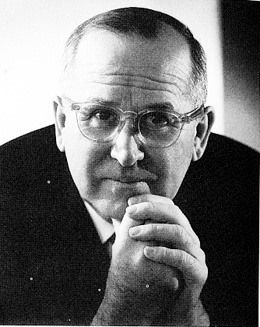Architect John Graham Jr. won international acclaim for his design of Seattle's celebrated Space Needle and for his large-scale shopping complexes. Combining architectural skill with business acumen, Graham helped shape Seattle after World War II.
In his Father's Footsteps
Son of John Graham Sr. (1873-1955), architect of a number of Seattle's landmark buildings, John Graham Jr. was a native of Seattle. In 1926, he enrolled in the University of Washington's architecture program. Transferring to Yale after two years, Graham graduated in 1931. He emerged with a fine arts degree in the midst of an economic depression and initially pursued a career in merchandising rather than architecture. This experience affected the direction of his highly lucrative career in design and development. When the economy began to recover in 1937, he joined his father's architectural firm. He left to practice in New York soon thereafter, but, when his father retired in 1946, he returned to Seattle to take over the family firm.
Enter the Shopping Mall
The post-World War II economy spurred suburban growth and expansive commercial development in Seattle and King County. Graham, groomed in retail management, recognized the potential for innovative design strategies. Collaborating with Bon Marché president Rex Allison, Graham began his long career as a developer and architect. Together, Allison and Graham conceived the Northgate Shopping Center (1946-1950). Its scale, concentration of shops, commodious parking, and easy highway access became a model for the suburban shopping center. Graham's firm immediately became a leader within this highly lucrative niche. Graham produced designs for numerous North American shopping complexes including:
- Capitol Court (1957) in Milwaukee
- Gulfgate (1962) in Houston
- Northshore (1958) in Peabody, Massachusetts
- Wellington Square (1960) in London, Ontario
- Clackamas Town Center (1981) in Portland, Oregon
Accomplishments
Of Graham's many designs and enterprises, the most singularly famous is the Space Needle, part of the Century 21 Exposition (1960-1962). Although Victor Steinbrueck (1911-1985) contributed to the final design, Graham is generally its acknowledged author. He submitted a patent for the revolving restaurant in 1961 while working on Ala Moana Shopping Center in Honolulu. which incorporated this novel design.
In 1974, he became partners with Roderick Kirkwood. This merger resulted in more than 1,000 large-scale, profitable commercial designs. The productivity of Graham and Kirkwood stemmed from the organization of their extensive offices, capable of managing all stages of development. Theirs was a quintessentially corporate design firm. Examples of Graham and Kirkwood's designs in Seattle include:
- 1600 Bell Plaza (1976)
- Westin Hotel and Towers (1979-1982)
- Sheraton Hotel and Towers (1978-1982)
The firm was also partially responsible for:
- The Alaska State Office Building (1972-1975) in Juneau, Alaska
- Bremerton's Naval Regional Medical Center (with Sherlock, Smith and Adams, 1978-1981)
- Madigan Army Medical Center (1984-1986) in Tacoma
Graham retired in 1986 and died on January 29, 1991, at the age of 82. His legacy appears in Seattle's metropolitan skyline. The corporate skyscraper and residential highrise were new to the city in the late 1970s. Like Eiffel's Tower, Graham's Space Needle has become an emblem of its city and a landmark treasured by most Seattle residents.

